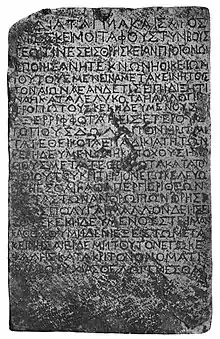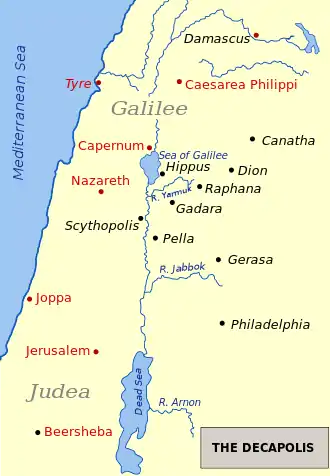Nazareth Inscription
The Nazareth Inscription or Nazareth decree is a marble tablet inscribed in Greek with an edict from an unnamed Caesar ordering capital punishment for anyone caught disturbing graves or tombs.[1] It is dated on the basis of epigraphy to the first half of the 1st century AD. Its provenance is unknown, but a French collector acquired the stone from Nazareth. It is now in the collections of the Louvre.[2][3]

The text is read by scholars in the context of Roman law pertaining to exhumation and reburial, mentioned also by Pliny.[4][5] The inscription is of interest to some authors for its indirect relationship to the historicity of Jesus, even though the text contains no reference to Jesus of Nazareth. A 2020 study of the marble's isotopes showed that the tablet came from a quarry in the Greek island of Kos, casting much doubt on the theory that it has any relationship to Jesus, and it may instead have been inscribed as a reaction to the desecration of the grave of the Kos tyrant Nikias circa 20 BCE.[6]
Description and provenance

The marble tablet measures 24 by 15 inches, with the koine Greek inscription appearing in fourteen lines. It was acquired in 1878 by Wilhelm Fröhner (1834–1925), and sent from Nazareth to Paris. Fröhner entered the item in his manuscript inventory with the note "Dalle de marbre envoyé de Nazareth en 1878." Though indicating that the marble was sent from Nazareth, the note does not state that it was discovered there. Nazareth was a significant antiquities market in the 1870s, as was Jerusalem,[7] and may have been "nothing more than … a shipping center" for the item.[8] Since 1925 it has been in the Bibliothèque nationale, Paris, displayed in the Cabinet des Médailles.
The inscription, with a facsimile, was published in 1930 by Franz Cumont,[9] who had been alerted to it by Rostovtseff.[7]
Text
The Greek used in the inscription is relatively poor.[10] Clyde E. Billington provides the following English translation:[11][12]
Edict of Caesar
It is my decision [concerning] graves and tombs—whoever has made them for the religious observances of parents, or children, or household members—that these remain undisturbed forever. But if anyone legally charges that another person has destroyed, or has in any manner extracted those who have been buried, or has moved with wicked intent those who have been buried to other places, committing a crime against them, or has moved sepulcher-sealing stones, against such a person, I order that a judicial tribunal be created, just as [is done] concerning the gods in human religious observances, even more so will it be obligatory to treat with honor those who have been entombed. You are absolutely not to allow anyone to move [those who have been entombed]. But if [someone does], I wish that [violator] to suffer capital punishment under the title of tomb-breaker.
Legal and cultural background
Violatio sepulchri ('tomb violation') was a crime under Roman law, as noted by Cicero (d. 43 BC). The Nazareth Inscription prescribes the death penalty for the offense.[13] A tomb at which funeral rites had been duly performed became a locus religiosus, belonging to the divine rather than to the human realm.[14][13]: 144 Roman Imperial tombstones are often inscribed with a curse (defixio) against anyone who desecrates the grave.[13]: 144
Analysis

Scholars have analysed the language and style of the Nazareth inscription and attempted to date it. It has been discussed in the context of tomb-robbery in antiquity.
Francis de Zulueta dates the inscription, based on the style of lettering, to between 50 B.C. and A.D. 50, but most likely around the turn of the era.[15] As the text uses the plural form "gods", Zulueta concluded it most likely came from the Hellenized district of the Decapolis. Like Zulueta, J. Spencer Kennard, Jr. noted that the reference to "Caesar" indicated that "the inscription must have been derived from somewhere in Samaria or Decapolis; Galilee was ruled by a client-prince until the reign of Claudius".[8]: 232
It was once of interest to historians of the New Testament.[7]: 89 Some authors, citing the inscription's supposed Galilean origin, interpreted it as Imperial Rome's clear reaction to the empty tomb of Jesus[2][7]: 89 and specifically as an edict of Claudius, who reigned AD 41-54.[16][17] If the inscription was originally set up in Galilee, it can date no earlier than 44, the year Roman rule was imposed there.[2]
However, the 2020 isotope study of the marble published in the Journal of Archaeological Science clarified the origin of the tablet and points to another interpretation.[18] The scientists took a sample from the back of the tablet, and used laser ablation to help determine the isotope ratio of the stone.[6] The enrichment of carbon 13 and depletion of Oxygen 18 allowed a confident identification of the source of the marble as the upper quarry in the island of Kos. The team proposed that the edict was issued by Augustus after the desecration of the tomb of the Kos tyrant Nikias.[19][6]
There is no mention at all made in the Nazareth Inscription of abusing a corpse but only of moving corpses to other locations with wicked intent. It also mentions multiple bodies being taken from tombs, not just one. Kyle Harper, one of the authors of the 2020 study, said that the theory that the Nazareth Inscription was written by Augustus because of the abuse of Nikias' corpse, “has not yet been proven”. Israel has no marble, so any marble would necessarily have to come from elsewhere — most likely from a location on the route from Rome to Judaea —, and the poor Greek makes it unlikely that the inscription was made in a Greek-speaking area.
References
- Gager, John G. (1992). Curse tablets and binding spells from the ancient world. New York u.a.: Oxford Univ. Press. p. 179. ISBN 9780195062267.
- Smallwood, E. Mary (1976). The Jews under Roman Rule: From Pompey to Diocletian: A Study in Political Relations. Leiden: Brill. p. 213.
- Millard, Alan (2000). Reading and writing in the time of Jesus. New York, NY: New York Univ. Press. p. 110. ISBN 9780814756379.
- Pliny, Epistles 10.68f.
- Phillips, C. Robert (2007), "Approaching Roman Religion: The Case for Wissenschaftsgeschichte", in Rüpke, Jörg (ed.), A companion to Roman religion ([Nachdr.]. ed.), Malden, Mass.: Blackwell, p. 14, ISBN 9781405129435
- Gibbons, Ann (February 28, 2020). "Tablet thought to have guarded tombs after Jesus's death may not be what it seems". Science Magazine. Archived from the original on February 29, 2020. Retrieved February 29, 2020.
- Metzger, Bruce M. (1980), "The Nazareth inscription once again", New Testament studies : philological, versional, and patristic, New Testament tools and studies, vol. 10, Leiden: Brill, pp. 75–94, ISBN 9004061630 Metzger gives a summary of discussion among New Testament scholars and ancient historians alike.
- Kennard, J. Spencer (December 1955). "The Burial of Jesus". Journal of Biblical Literature. 74 (4): 227–238. doi:10.2307/3261668. JSTOR 3261668. noting the coincidental connection with the burial of Jesus made by Baldensperger, Cumont and Momigliano.
- Franz Cumont, "Un réscrit impérial sur la violation de sépulture" in Revue Historique 163 1930:341-66.
- Elwell, Philip W.; Comfort, Walter A., eds. (2008). Tyndale Bible dictionary. Carol Stream, Ill.: Tyndale House Publishers. p. 939. ISBN 978-1-4143-1945-2.
- Billington, Clyde E. "The Nazareth Inscription: Proof of the Resurrection of Christ?". Artifax (Spring 2005).
- "SEG 8:13 - PHI Greek Inscriptions". epigraphy.packhum.org. Archived from the original on 2017-02-23. Retrieved 2017-02-23.
- Kyle, Donald G. (1998). Spectacles of death in Ancient Rome. London: Routledge. pp. 143–144. ISBN 9780415096782. citing Cicero, De Legibus 3 and Digest 47.12, with additional citations of modern scholarship.
- Gaius, Inst. II.3, 6, 9; Clust. 3.44.2
- De Zulueta, F. (1932). "Violation of Sepulture in Palestine at the Beginning of the Christian Era". Journal of Roman Studies. 22 (2): 184–197. doi:10.2307/296822. JSTOR 296822. S2CID 164019744.
- Cadbury, Henry J. (1955). The book of Acts in history (2004 ed.). Eugene, Or.: Harper. p. 117. ISBN 978-1592449156.
- Green, Michael (1967). Man alive!. Downers Grove, Ill.: Inter-Varsity Press. p. 36. ISBN 9780877845379. "It is an imperial edict, belonging either to the reign of Tiberius (A.D. 14-37) or of Claudius (A.D. 41-54). And it is an invective, backed with heavy sanctions, against meddling around with tombs and graves! It looks very much as if the news of the empty tomb had got back to Rome in a garbled form. (Pontius Pilate would have had to report: and he would obviously have said that the tomb had been rifled). This edict, it seems, is the imperial reaction."
- Harper, Kyle; McCormick, Michael; Hamilton, Matthew; Chantal, Peiffert; Raymond, Michels; Engel, Michael (April 2020). "Establishing the provenance of the Nazareth Inscription: Using stable isotopes to resolve a historic controversy and trace ancient marble production" (PDF). Journal of Archaeological Science: Reports. 30: 102228. doi:10.1016/j.jasrep.2020.102228. S2CID 212890727.
- Bower, Bruce (2020-03-20). "The Nazareth Inscription's origins may refute ties to Jesus' resurrection". Science News. Archived from the original on 2020-03-20. Retrieved 2020-03-21.